Earlier this week, we posted the results of our ballistic gelatin testing for 38 different self-defense loads in .38 Special and .357 Magnum. Each load was tested with both a 2 and 4-inch barrel fired into Clear Ballistics brand gelatin blocks with a 4-layer heavy fabric barrier to simulate clothing. You can see the full results in our fancy high-tech interactive charts at Lucky Gunner Labs. If you haven’t already, I highly recommend taking a look at those results before moving on to the rest of this article. This is just the post-game commentary, and it might not make much sense unless you’ve seen the main event.
For the loads I mention below, I have provided links to their individual product pages where you can see the test results for that particular load. To compare those results to all the other loads tested, you’ll want to check out that Labs post.
If I had to summarize all the results in one sentence, I’d say we saw a handful of .357 loads that performed about the same as a good 9mm along with a few .38s that were almost as good, minus a couple of inches of penetration. A slightly less succinct version of my commentary can be found in the video below, or keep reading for the unabridged edition.
In case you missed our previous ballistic gel tests, basically, we are looking for bullets that consistently penetrate between 12 and 18 inches, based on the guideline established by FBI research. Most good hollow points will also expand in the gelatin to at least 150% of their original diameter — about .54” for both .38 Special and .357 Magnum. Of course, no matter what ammo we’re looking at, good shot placement is key and there is no magic bullet that will make up for deficiencies in skill and mental preparation for dealing with violence. So with that in mind, let’s take a look at some of the highlights from our test results.
.38 Special Highlights
.38 Special is often considered a bit underpowered, so it’s no surprise that most of the loads that we tested were unable to meet those guidelines for penetration and expansion. We fired five rounds of every load through each of the two test guns. If you throw out all the loads that had any failures to sufficiently expand or penetrate, you’re left with just two .38 Special loads that met the standards with both of the test guns: the Winchester 130 gr +P Ranger Bonded and the Remington 125 gr +P Golden Saber.
Unfortunately, the Winchester Ranger load is typically marketed and sold only to law enforcement and it can be difficult to come by on the commercial market (we have rarely been able to stock it). But keep in mind, those penetration and expansion standards are pretty loose guidelines, so some of the loads that came close are probably still good choices. It just so happens the Winchester 130 gr +P PDX1 Defender and the standard pressure Winchester 130 gr Train and Defend both use the same bonded hollow point bullet as the Ranger, only with slightly less velocity. Those loads didn’t do quite as well as the Ranger through the 2-inch barrel, but I think they are both still worth considering.
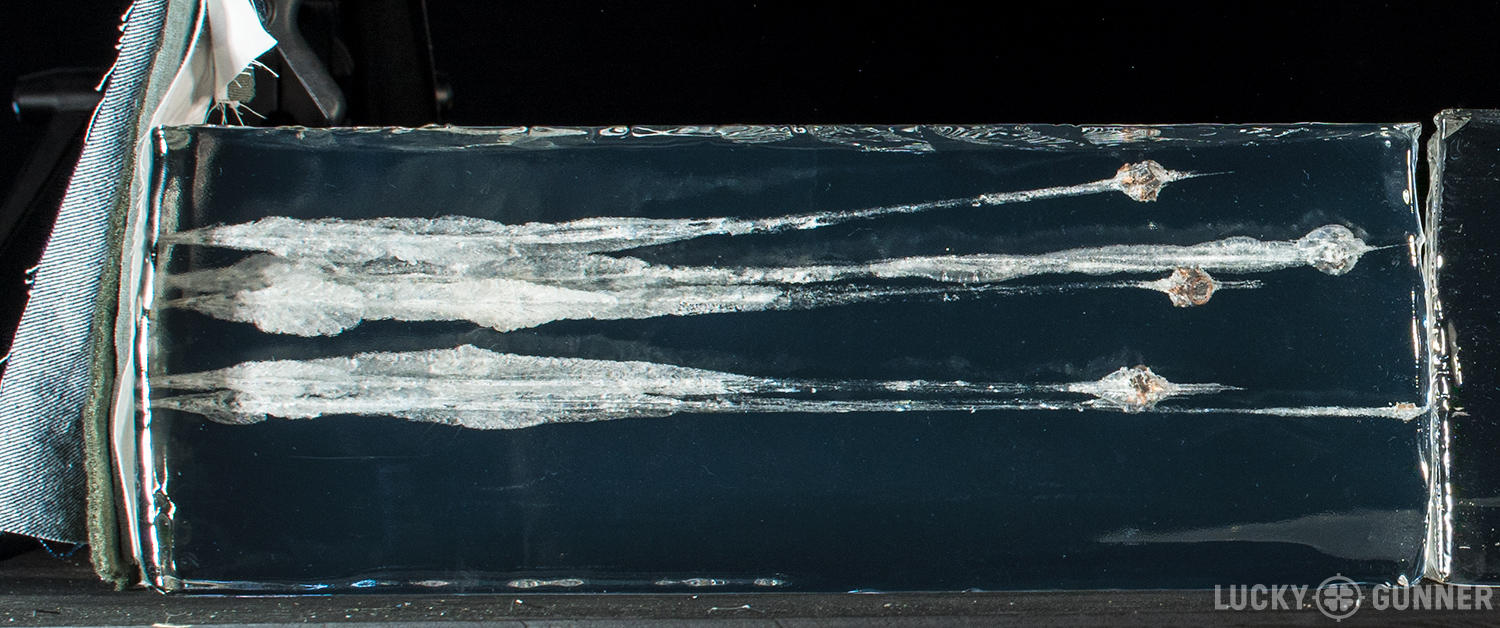
I personally had high expectations for the Speer 135 gr +P Gold Dot Short Barrel load, but was sorely disappointed by the test results. With the 2-inch barrel, the Gold Dots barely expanded at all, and even the extra velocity of the 4-inch barrel was not enough to prevent expansion failures. Fortunately, as we’ll see below, the same bullet did much better when pushed to magnum velocities.
The FBI Loads
We tested three different versions of the so-called “FBI load” — the 158 grain +P Lead Semi-Wadcutter Hollow Point (LSWCHP) that used to be a favorite of law enforcement back in the revolver days. Winchester, Federal, and Remington still each produce their own FBI load with slight differences in velocity and the hardness of the lead. In our tests, the Remington version fired through a 4-inch barrel had pretty good results, but only one of the five rounds expanded when fired through the 2-inch barrel. The Winchester FBI load had very similar performance, but with slightly less expansion in the 4-inch barrel than the Remington load. Federal’s version of the FBI load completely failed to expand with all ten rounds fired.
“In general, barrel length did not have a major impact on performance for the .38s that we tested. The loads that failed to penetrate or expand typically failed with both test guns.”
In general, barrel length did not have a major impact on performance for the .38s that we tested. The loads that failed to penetrate or expand typically failed with both test guns. The Remington and Winchester 158 gr +P LSWCHP loads were the only .38 Specials that did well with the 4-inch barrel but not with the 2-inch barrel.
Low Recoil .38 Special Options
The popularity of lightweight snub nose revolvers has many shooters in search of a .38 Special load with reduced recoil. The Hornady 90 gr Critical Defense Lite was probably the mildest hollow point we tested, but I was not impressed with its shallow penetration averaging around 11”. Expansion was consistent but limited with an average of .44”. Federal’s 110 gr Hydra Shok Low Recoil load had slightly better penetration, but even less expansion than the Hornady Lite. The standard pressure version of Hornady’s 110 gr Critical Defense is not advertised as a low recoil load, but could easily pass for one. Its performance was similar to the Hornady Lite, except with sufficient expansion at just over 14” with both barrels. The Winchester Train and Defend mentioned above was also a light recoiling load with good performance.
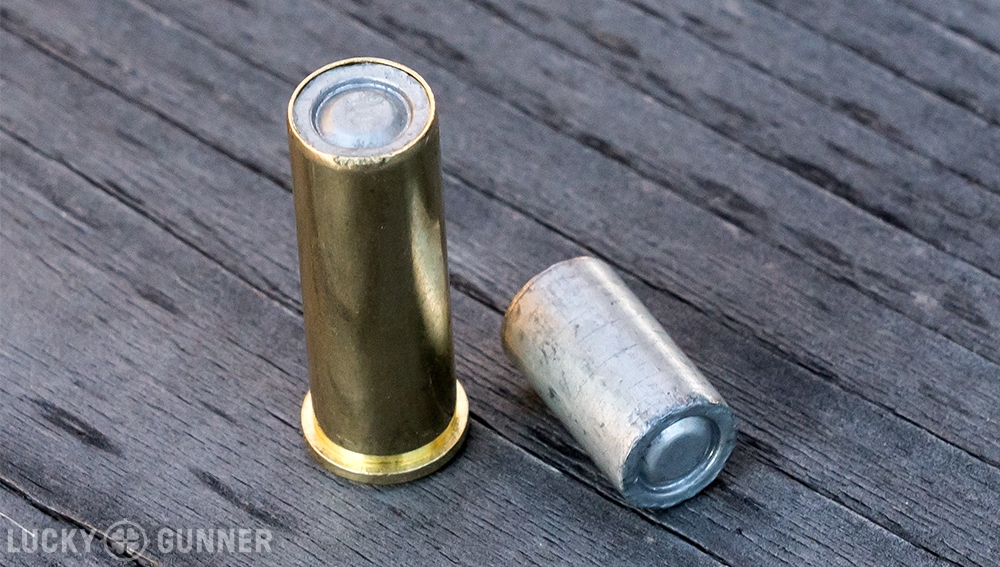
My personal favorite reduced recoil load is one that’s easy to overlook: the Winchester 148 gr Super-X lead wadcutter. This load easily had the least amount of felt recoil out of all the guns we tested, yet it penetrated to about 16” out of both test barrels. None of the bullets expanded, but they are not designed to. As I explained in my wadcutter article last year, the sharp shoulder of the wadcutter bullet crushes soft tissue, creating more of a hemorrhaging effect than a simple round nose bullet or a hollow point that fails to expand.
This benefit is not apparent when looking at the gel test results, but for many years, ballistics researchers have noted that the real-world effectiveness of the humble wadcutter is far greater than its minimal recoil would suggest. The Winchester wadcutter, along with the lead wadcutter loads from both Federal and Remington, make excellent loads both for practice and self-defense for the ultra-lightweight revolvers or for inexperienced shooters or anyone who struggles with the recoil of their revolver for any other reason. That said, for steel frame revolvers and more experienced shooters, an expanding hollow point is probably the way to go.
.357 Magnum Highlights
Moving on to the .357 Magnums, only 4 out of the 20 that we tested had any failures to expand and there were just a couple of instances of under-penetration. But over-penetration was fairly common. Barrel length did make more of a difference here than with the .38s. Depending on where you draw the line for acceptable penetration, there were 4 loads that did well with the 4-inch barrel but not with the 2-inch snub nose: the Speer 125 gr Gold Dot, Hornady 125 gr XTP, Buffalo Bore’s short barrel loading of the Barnes 125 gr XPB bullet, and the venerable Federal 130 gr Hydra-Shok.
On the flip side, another 4 loads showed ideal results with the 2-inch barrel but over-penetrated with the 4-inch barrel: the standard loading of Buffalo Bore’s Barnes 125 gr XPB, the Remington 158 gr SJHP, the Barnes 140 gr XPB VOR-TX, and Federal’s Vital-Shok using the same 140 gr Barnes XPB bullet.
It has frequently been said that magnum loads fired through a snubby revolver are unlikely to be any more capable than a .38 +P, but looking at our test results, that does not seem to be the case. Instead, we see that each of these bullets appears to have a specific velocity window in which it will reliably expand. If the particular revolver being used pushes the bullet either too slow or too quick to hit that window, a fabric barrier may be all it takes to prevent the bullet from expanding. Some of these loads might deliver adequate performance if they are matched with the right revolver, but an ideal defensive load will have a large enough “window” that it is likely to expand with the barrel length and velocity of any common 2 to 4-inch barreled revolver.
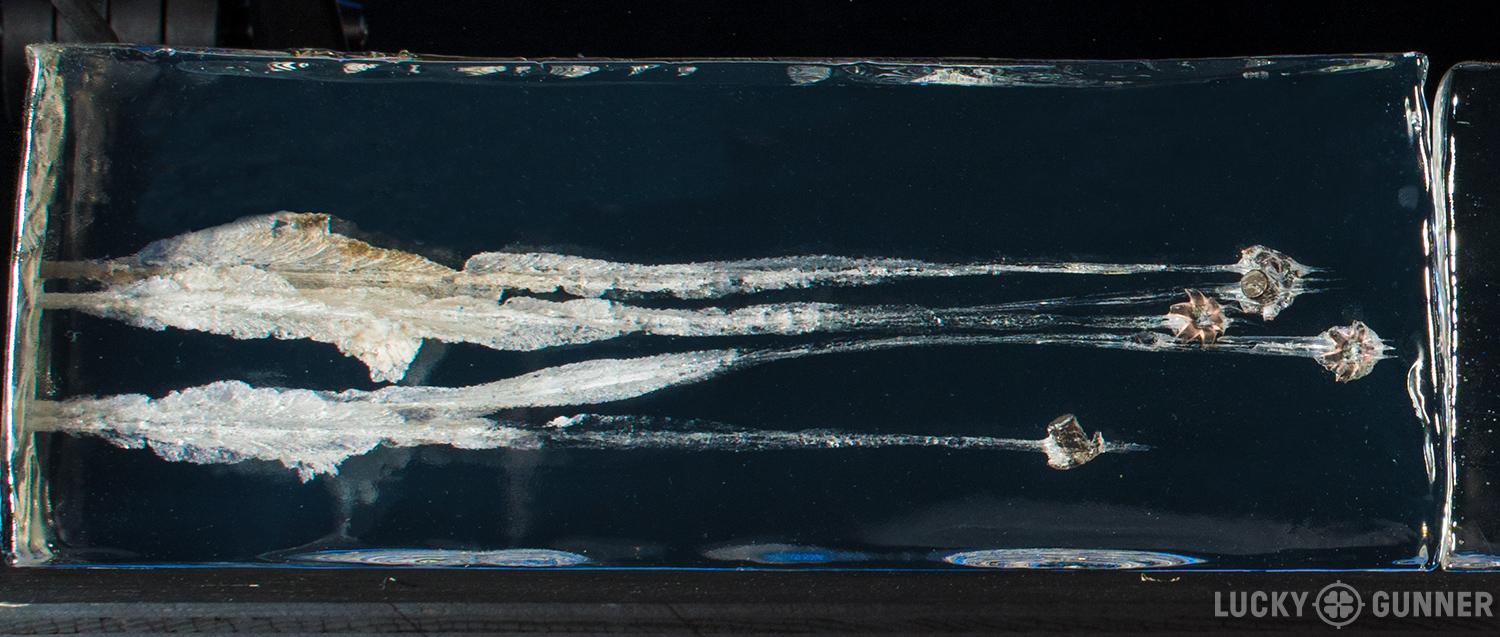
When we narrow our gel test results down to magnum loads that stayed within the 12”-18” range and had consistent expansion out of both barrels, we get four solid performers: Barnes 125 gr Tac-XPD, Corbon 110 gr JHP, Speer 135 gr Gold Dot Short Barrel, and the Winchester 125 gr PDX1 Defender. These loads all averaged between 12 and 16 inches of penetration with expansion of no less than .55”. The Barnes load was the standout for expansion with a .75” average from the 2-inch barrel and .69” from the 4-inch. If we allow for just a couple of inches of over-penetration, we can add the Remington 125 gr Golden Saber to the list. The Hornady 125 gr Critical Defense load wasn’t bad either, though it only expanded to .52” with the 2-inch barrel.
Low Recoil .357 Magnum Options
Gel test results can be useful, but they don’t tell you anything about the effects of recoil. Unfortunately, there is just no practical way to quantify that and put it on our chart. Even so, there is a world of difference between shooting a standard pressure .38 and a high-velocity magnum load and not just in terms of discomfort. Generally speaking, .357 Magnum delivers more recoil than the average gun owner can manage without significantly impairing their ability to shoot quickly and accurately.
“Generally speaking, .357 Magnum delivers more recoil than the average gun owner can manage without significantly impairing their ability to shoot quickly and accurately.”
Now, if you are not like the average gun owner and you actually practice on a somewhat regular basis, you can probably get decent results shooting some of the less severe magnums out of a steel frame revolver. Out of the six magnum loads that did exceptionally well in our tests, three of them had relatively low recoil compared to the others: The Winchester PDX1, the Remington Golden Saber, and the Speer 135 gr Gold Dot short barrel load. I would probably use one of those three if I wanted a good self-defense magnum load. Looking at the gel test results, there is not a significant difference between these and the loads with heavier recoil.
But also keep in mind that the performance of these magnum loads is also pretty much identical to some of our 9mm loads from the short barrel semi-auto gel tests. For both calibers, the best performing loads showed around 14″-18″ of penetration with an expanded bullet average somewhere between .55” and .75”. There are plenty of reasons you might want to use a revolver instead of a semi-auto for self-defense, but if you’ve primarily been drawn in by the allure of the awesome power of the .357 magnum, you might consider that you could probably get the same ballistic performance out of a 9mm but with a lot less recoil, noise, and muzzle blast. And for that matter, you really aren’t losing a whole lot if you go to one of the better .38s that we tested, and I think that’s going to strike the ideal balance between recoil and effectiveness for most people, particularly in short barrel carry revolver.
I’ll be diving into this issue of recoil a little deeper in my next article. For now, go take a look at the full test results and if you find this kind of thing helpful, please consider supporting these projects by getting your ammo from Lucky Gunner.


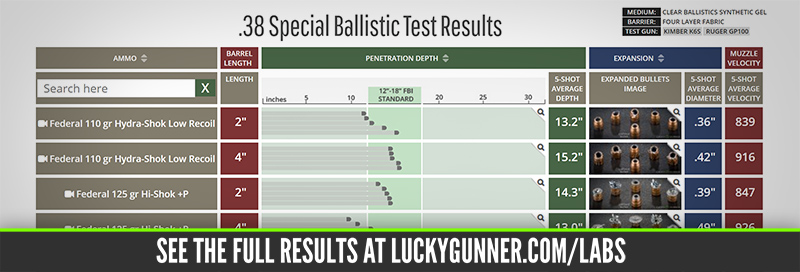
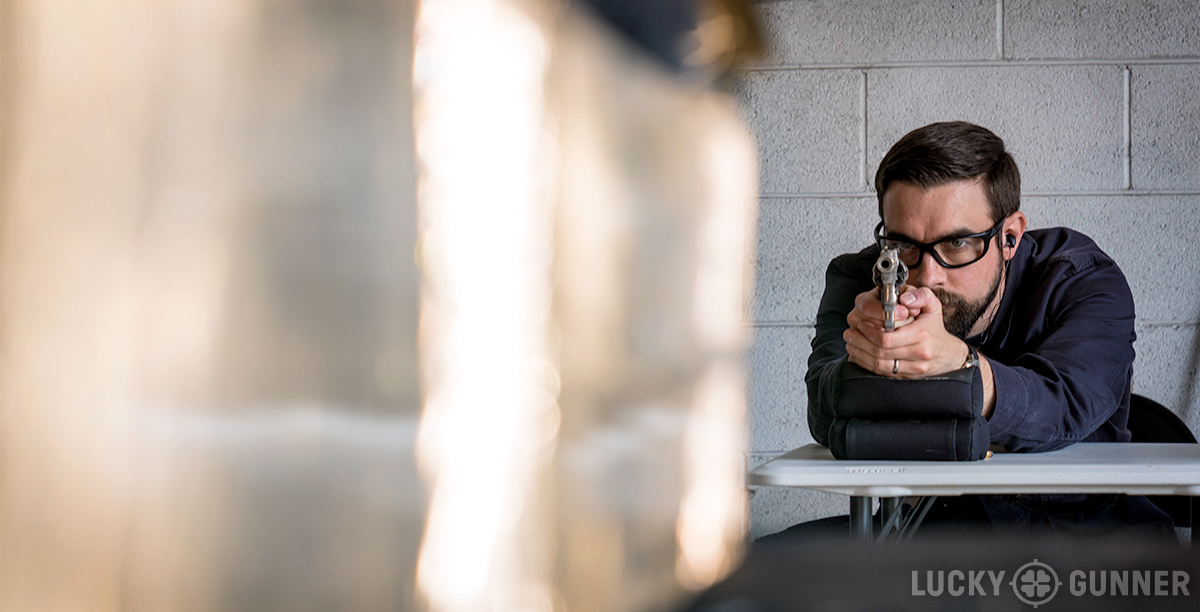
You are saying that a .357 does the same as a 9mm?? I don’t think so!
I didn’t read that in the articles. It seems that a handful of maggies approach the penetration of 9mm. YRMV
I’m not saying that. Our test results are saying that.
The difference between 9mm and 357mag is the use of heavier ( longer bullets) 158-180 gr..
357 mag has similar energy levels to full power 10mm ..
Don’t get caught up in this gel test … Its good for getting a Idea on how a bullet may perform ..
But its not adrenaline driven flesh and bone..
Well, no kidding….bullets that properly expand and stay within the 12-18 inch window are all going to perform very similarly in the gel, visually, in this regard. What you’re not capturing is the differences in the energy dump the bullet is imparting to the gel – the 357 is significantly out-performing the 9mm in this regard, especially the 4″ barrel, even when comparing 124gr 9mm vs 125 gr .357
“Energy dump” is not a significant wounding mechanism in handgun bullets.
I notice the mention of the use of wadcutters – even better from years ago is hand loading them holllow base forward – they expand amazingly but not sure of the maximum penetration. A highly recommended load for short barreled revolvers like the Colt Detective special.
No, that’s not even better.
The backwards HBWC thing is a myth.
you are wrong – have used them that way for years and have been written up in many mag articles – the only problem is they lead the barrel pretty fast
Personally, I like the Winchester Train & Defend 38 SPL ammo. Glad to see the endorsement, even if understated. Often T&D is priced about the same as so-called “cheap stuff”, but it carries quality bullets with consistent performance and lower recoil; very comfortable in my little Taurus 85. I also like the T&D in 9mm. Don’t notice any reduction in recoil so there doesn’t seem to be any gains there; however, from my Shield the 147 grain round is extremely accurate, even better than the 124 grain Federals I used to carry.
Thanks for taking the time to do these tests and compile the info. I notice your results mirror my research on one particular subject: if you are going to use Hornady Critical Defense, ignore the +P load; that 110 grain bullet just doesn’t seem designed for the +P velocity.
If you talk about quantifying recoil in your next video, I have found that (as a general rule of thumb) I dislike more that 20 fps of free recoil speed. The energy doesn’t seem to make a huge difference to me, but the speed is very noticeable if it is too much. It might not be possible to really determine what is “normal”, but I would love to get a better feel for whether “normal” people are more bothered by speed or energy and where those thresholds might be. Recoil sensitive vs not recoil sensitive doesn’t really illuminate the subject much when researching ammo options much.
Since you are using ballistic gelatin, I would like your input on a matter that has been raised in a few forums, and I had personal experience at a training class recently. The instructor tried to tell us that it was better to spread your shots over the body than to concentrate fire on a point on the body. He further rationalized that since tests into ballistic gel produced cavities, it was better to spread. I asked if that was why shotgun blasts were so ineffective, since a 00 Buck round has 9 pellets and they are concentrated in one spot. He was taken aback, and I further added that while ballistic gel is a great test medium, it isn’t the human body which has nerves/bones/muscles/blood vessels. I maintain that accurate shot placement is better than spreading, having seen gunshot wounds as a LEO, and being a combat vet.
Now, after all that, have you encountered that opinion?
Shot placement is key. If you don’t get the first shot in a place that will immediately disable, then it doesn’t make much sense to put other shots there too. If you put the first round in the right spot, it won’t matter what areas the other rounds go on the target. Really though, especially in a stressful situation, I suspect the vast majority of people will be concentrating on hits of any kind. Also, I don’t think shotgun buckshot rounds typically stay in one spot once it hits gel or something solid.
That’s the first I’ve heard of the concept of intentionally “spreading out” your shots (except in the context of switching targets if hits are ineffective, such as trying head shots when hits to center mass do not stop the attacker). Maybe I’m understanding it incorrectly, but I can’t imagine anyone actually familiar with internal wound ballistics and the dynamics of violent encounters advocating a practice like that.
Thanks, I can’t imagine that either, but it’s out there.
This isn’t the first time I’ve heard of it, the idea being to “spread out the damage” operating on the theory that involving multiple major organs will increase effectiveness on target.
I don’t know about that, but I do know that statistically, an individual suffering GSW is less likely to survive multiple such injuries vs. one.
That “spread the damage” bullshit has been around for awhile now, it’s used to justify not being able to shoot a group.
In real life there is no way your rounds will stack in the same hole, because people move.
Two rounds through the same wound track would actually make the damage worse in that area, because tearing already damaged tissue is a real thing.
That instructor is an idiot.
That instructor sounds like an idiot, teaching “spraying and praying.” If you cant group five shots at seven yards within two inches, then guns are not for that person. I’m a former Marine combat vet, shot placement is key.
Its my opinion, based on nothing more then this test and a couple other tests of the .38 Special Remington FBI load, that the “HTP” line may be lower powered by just a hair compared to the “Express” line.
This is unfortunate, because at 840-860fps the LSWCHP performs better then at the current 800fps that the load now seems to be getting from snubnose revolvers.
Of course, this could be because of common variations from test to test based on ammo lot or barrel length or whatever, but I’m sure I’m not the only person to notice that Remington’s HTP rendition of the classic FBI load is a disappointment, based on chronography tests of the relatively new (as of this date) HTP that I’ve seen done by a couple different folks that confirm the seemingly lower velocity of the load.
Lucky Gunner is the first to actually test this new rendition of the Remington FBI load in gel. Thanks, guys!
I’ve seen other tests where the Gold Dot and the FBI load don’t do too well in the 4 layer denim tests, but seem to do ok in bare gel and “light”(T-shirt) to “heavy”(down filled jacket, flannel, T-shirt) clothing tests. So its not that big a surprise to me to see your results.
That being said, with a lower powered caliber like .38 special, IMHO- any load that consistently opened up and penetrated well, especially being that this was a tough 4 layer denim test, is a winner.
Thank you very much for the time, effort, and cost in doing these tests, guys.
Hope it was fun!
Chris, what did you guys think about the wadcutters having all of that clothing material on them? Do you think the clothing trapping itself affects the “sharp shoulder” and therefore the “hemorrhaging effect”?
I don’t believe a little bit of material sticking to the face of the bullet would significantly diminish the crushing effect, but I honestly couldn’t say for sure. What I do know is that wadcutters have a fairly good track record in real world shootings as long as they don’t have to first pass through an intermediate barrier like a windshield.
This project is the most concise, readable, understandable and therefore most useful of its type I have seen. Others have picked nits but I offer my sincere thanks for your hard work.
I too own a Match Champion and am about as high on it as you seem to be. I left mine with Teddy Jacobson in Sugarland, TX. The DA pull is now under 9lbs and smooth as buttah. The SA is under 5lbs and crisp. I ordered the old-style rubber stocks from Ruger. A more versatile and enjoyable range/field/home defense revolver I cannot imagine. In it, I tried a couple of the loads you tested and offer my observations. The Winchester Ranger 130gr +P was as accurate in my gun as I’ve heard from others and recoil was very manageable. But the flash was surprising. I assumed this load would be effectively suppressed but you couldn’t prove it with my box. I intend to try the latest iteration of this load called “Defender” and see whether it’s any better. If that works out I believe this load may be, by a very small margin, the best of the bunch.
I also tried the Hornady Critical Defense 110gr +P and can report virtually no visible flash. However, accuracy in my gun was poor. Recoil was slightly less than the previous load. Hopefully my experience will be useful to someone.
I appreciate your practical, realistic approach to this field which is so evident in your other articles as well. After a bunch of striker-fired pistols, I too recently returned to the DA auto pistol even though I came of age with the erudition and wisdom of Jeff Cooper. I have become a trigger snob over the years but not to the point of investing in a 1911, though I somehow managed to qualify Expert with one as a teenager in boot camp. After decades of searching for the perfect pistol, I am currently settled on the CZ P-07. Like many others I find the ergonomics, comfort and shootability to be matchless, though their older pistols and the original Sig P225 come close ( I have smallish hands). I wasn’t even aware it existed and just saw it hanging on the wall at the range. On an impulse I rented it and am glad I did. I think it would make a good topic for your next article. I am prepared to have my mind changed again as soon as I can get my hands on the new P10. Maybe it’s a sickness but I have no plans to recover.
Great data; very useful in helping my wife pick the best ammo for her 9mm! Y’all should do 10mm and .357 Sig next.
Chris (or anyone) this question may not exactly pertain to this thread but it is related and this is the closest topic I can find. Will a .38 bullet fired out of a .357 revolver lose some fps as compared with the same bullet fired out of the same gun that is designated ONLY for .38? Though of course .38’s can be fired out of a .357 I heard somewhere about “venting” (?) occurring when a .38 is shot in a .357 gun because the .38 shell is slightly shorter? I have asked this question on several gun forums but have not gotten a real straight answer? For example, I bought a SP101 in .357 intending to only shoot 38+P with it because I figured – what the heck, the .357 model is the same except it’s reinforced so why not get the .357? Now I wonder if I made a mistake if I only intended to shoot .38’s – am I losing velocity compared with the .38 model SP101?
Not enough to matter. Of the factors affecting the outcome of a defensive shooting, this one doesn’t even register as being marginally significant.
Gracias.
Here some fact about 38 and 357 shot out of 357 revolvers (S&W 686 6” ) I do reloading found that you load Both 38 and 357 with the same powder charge and bullet weight 140gr keeping charge Below +p level the 38 will go 100fps faster Reason for this is that the 38 casing being shorter provides more pressure
Great article! My first revolver, S&W 357, Model 13. It was a beast when I was 19, now I’m 60. Over the years I acquired a Ruger SP101 and a pre-Remington Marlin 1894C. I use 38+P in the revolvers, less recoil. The Marlin is a pleasure to shoot 357’s, including Buffalo Bore.
I’d like to see a Marlin 357 gel test, if you’re bored.
I agree the 9mm is the better option compared to a 357 revolver. And you can get a good 9mm for less than a 357 revolver. Coming from a one cartridge is better, I’d suggest a Glock 9mm with a Kel-Tec Sub-2000, that’s about $1,000. But I’m not parting with my 357’s.
@ LG Chris:
Do you have any plans in the near future to test the relatively newer Federal 130gr .38 +P HST? Not a lot of info about it concerning results, would love to see it put through your tests.
Thanks!
Thank you for the informative article.
Ya’ll have confirmed my decision to buy the wife a 38.
While critical lite may not be to the author’s taste; the incredible light recoil make it perfect for a new senior shooter like her.
Your test show that this round will be more then adequate for home defense.
130 grain fmj are light enough for practice, though the report from a 2 1/2 inch barrel is more intense.
This is quite a change from the 158 grain rounds of my youth.
Hadn’t looked at a 38 for 30 years, 9mm filled my needs until now. Very pleasantly surprised
Thanks again..